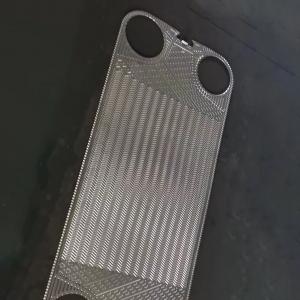

Add to Cart
Product Description
Innovative Heat Exchanger GEA Heat Exchanger Plate Component For Efficient Heat
GEA Heat Exchanger Plates
Introducing the innovative GEA Heat Exchanger Plate, a state-of-the-art component engineered to maximize heat transfer efficiency across various industrial applications. These plates are meticulously manufactured using premium materials like stainless steel or titanium, known for their outstanding corrosion resistance. With their corrugated design, these plates further enhance heat transfer efficiency, delivering unparalleled performance in heat exchange processes.
Features of GEA heat exchanger plates include:
1. Efficient heat transfer : The corrugated design increases the surface area of the plate and promotes heat exchange efficiency.
2. Corrosion resistance : Common materials such as stainless steel or titanium have good
corrosion resistance and are suitable for various industrial
environments.
3. Flexibility : Suitable for a variety of industrial applications, different
models and specifications can be selected according to needs.
4. Easy to maintain : Simple design, easy to clean and maintain, extending service life.
5. Space saving : The compact design saves space and is suitable for installation
sites with limited space.
The GEA heat exchanger plates play a crucial role in diverse industries, including food processing, chemicals, pharmaceuticals, and heating, ventilation, and air conditioning. Renowned for their exceptional efficiency, these plates offer highly effective solutions for transferring heat energy in various industrial production processes.
| Brand | Model |
| GEA | VT04,VT10,VT20,VT40,VT80,VT405,VT2508,N40,FA184,NT50,NT100T, NT100M,NT100X,NT150S,NT150L,NT250S,NT250M,NT250L,NT350S, NT350M,NT500 |
| Material | Specification |
| Stainless Steel | SUS304 316 316L 310S 904 |
| Titanium and titanium-palladium alloy | TAi TAi-Pd |
| Hastelloy | C276 D205 B2G |
| Nickel | Ni200 Ni201 |
| Molybdenum | 254 |
Applacations
| Plate material | Suitable for fluids |
| Stainless steel (SUS304.316, etc.) | Purified water, river water, edible oil, mineral oil |
| Titanium and titanium palladium (Ti, Ti-Pd) | Sea water, salt water, salt compounds |
| 20Cr,18Ni,6Mo(254SMO) | Dilute sulfuric acid, dilute salt aqueous solution, inorganic aqueous solution |
| Nickel (Ni) | High temperature, high concentration caustic soda |
| HASTELLOY alloy (C276, D205, B2G) | Concentrated sulfuric acid, hydrochloric acid, phosphoric acid |
GEA PHE (Plate Heat Exchanger) liquid processing systems operate similarly to other plate heat exchangers. In a GEA PHE system, the heat exchanger plates facilitate the transfer of heat between two fluids without them mixing. Here's how it typically works:
1. Fluid Circulation: Two separate fluids flow through alternating channels formed by the heat exchanger plates. One fluid is typically heated or cooled while the other acts as a coolant or heating medium.
2. Heat Transfer: Heat is transferred from the hot fluid to the cooler fluid through the thin plates. The corrugated design of the plates creates turbulence in the fluid flow, enhancing heat transfer efficiency.
3. Temperature Adjustment: As heat is exchanged between the two fluids, the temperature of the hot fluid decreases or increases, depending on whether it is a cooling or heating process.
4. Efficient Heat Exchange: The large surface area of the plates allows for efficient heat transfer between the two fluids, making GEA PHE systems effective for liquid processing applications.
Through the utilization of GEA PHE liquid processing systems featuring heat exchanger plates, industries can effectively achieve precise temperature control, optimize their processes, and uphold the superior quality of their liquid products.
Q&A
1. Q: Are you a manufacturer or trading company?
A: We are a professional manufacturer of plate heat exchangers, plates, gaskets, plate mould with 18 years' experience.
